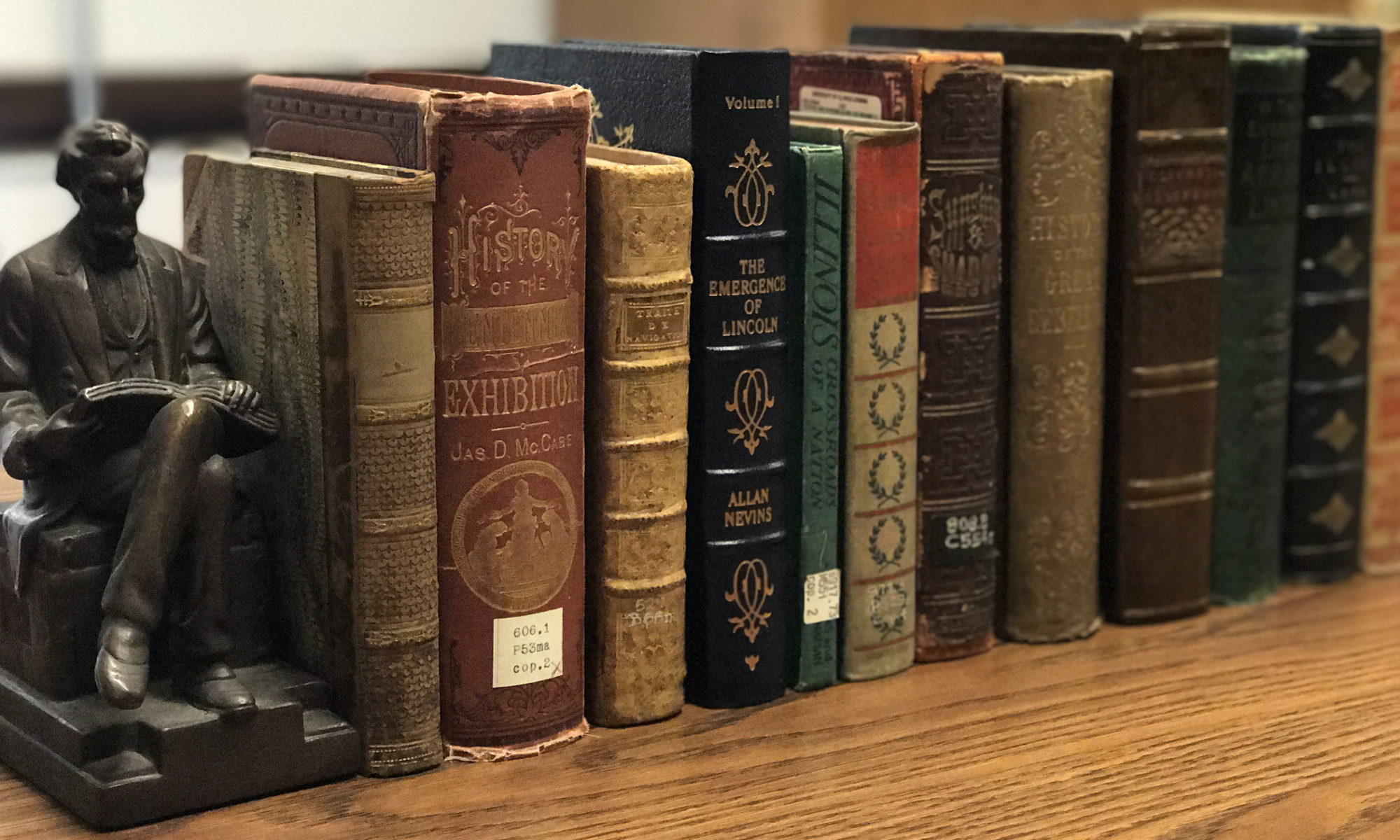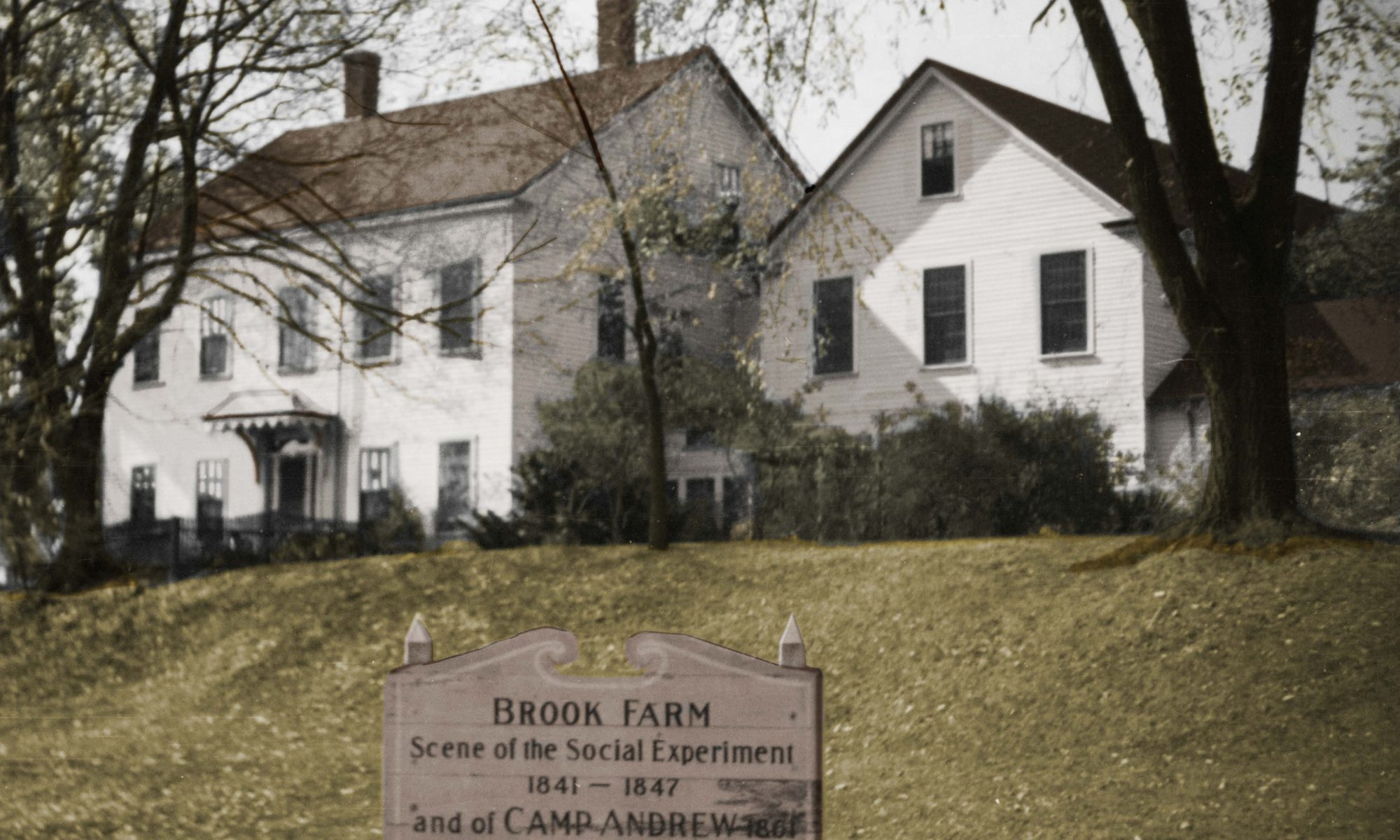Constructing Utopias: Examining Communitarianism Efforts in America, 1825-1940
This exhibit explores the communitarian movements of the United States, as well as the research done on them, through the research collections and personal papers available at IHLC. Influenced by European philosophers and thinkers, communitarian ideas were put into practice here in the United States and in Illinois.
The 19th-century communitarian movement encouraged the de-individualization of households in favor of communal living and shared work typically centered on a return to agrarian practices. Guided by the theories of French philosopher Charles Fourier (1772-1837) and Welsh social reformer Robert Owen (1771-1858), many secular communities (often called “colonies” or “phalanxes”) were created in the United States throughout the Northeast and Midwest.
Charles Fourier believed that individuals living communally would maintain a perfectly balanced society, and would achieve both Earthly (personal and social) and Cosmic harmonies. He promoted a return to agriculture, education in both science and the arts, women’s equality, and the idea of “attractive work”—labor in which people found pleasurable.
Robert Owen advocated for labor and educational reform, particularly for better working conditions and early childhood education. Like Fourier, he was interested in the benefits of communal life. To put his desire for a cooperative society into practice, Owen looked to the United States. With American geologist William McClure, he purchased the town of New Harmony, Indiana. The New Harmony colony had nearly 800 residents and practiced communal life from 1825 until it dissolved in 1827. Unlike Owen, Fourier never enacted his theories.
In the quest for Utopia, these communitarian colonies challenged contemporary ideals of individualism and industrialization. Communitarianism efforts continued into the early 20th century, though most colonies faded out by the end of the Depression era.
The full exhibit booklet may be downloaded here.
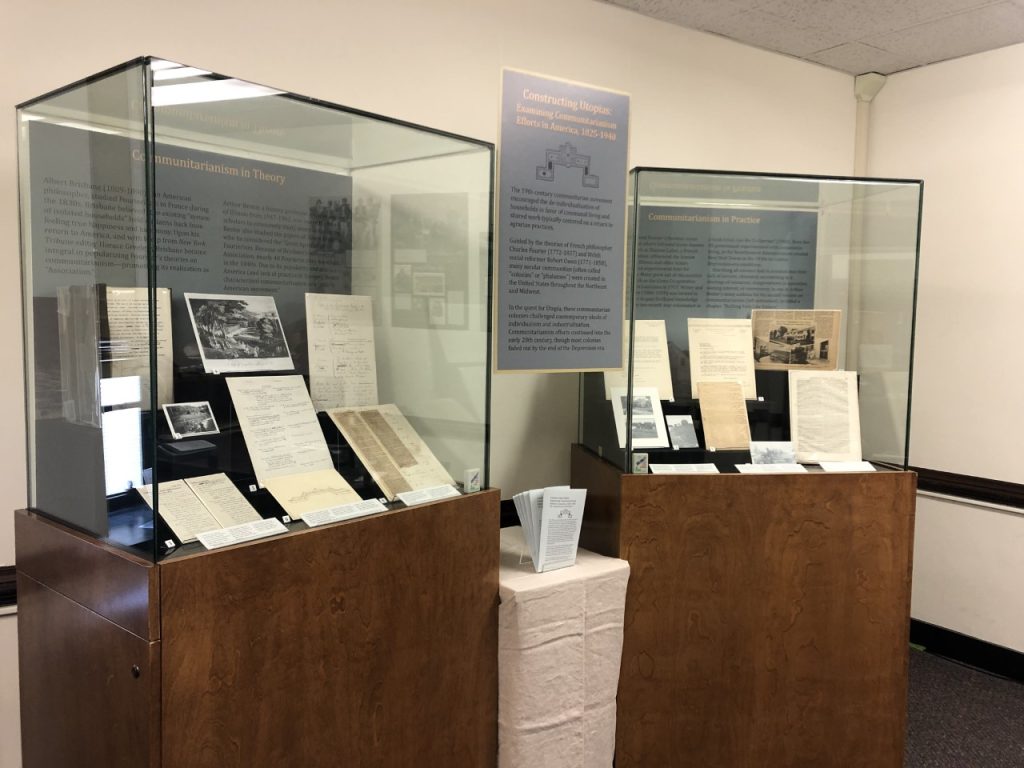
Case 1: Communitarianism in Theory
Albert Brisbane (1809-1890), an American philosopher, studied Fourierism in France during the 1830s. Brisbane believed the existing “system of isolated households” held citizens back from feeling true happiness and harmony. Upon his return to America, and with help from New York Tribune editor Horace Greeley, Brisbane became integral in popularizing Fourier’s theories on communitarianism—promoting its realization as “Association.”
Arthur Bestor, a history professor at the University of Illinois from 1947-1962, was one of the first scholars to extensively study communitarianism. Bestor also studied the papers of Albert Brisbane, whom he considered the “Great Apostle” of Fourierism. Because of Brisbane’s advocacy of Association, nearly 40 Fourierist sites were built in the 1840s. Due to its popularity and practice in America (and lack of practice in Europe), Bestor characterized communitarianism as a “strictly American movement.”
Bestor studied all facets of communitarianism and created lists and notes of non-Fourierist and non-Owenist communities for his research. His first book, Backwoods Utopias (1950), centered on the New Harmony colony and Owen’s influence on America. After the creation of New Harmony in 1825, twelve colonies were soon modeled after Owen’s vision. However, by 1830, all Owenist colonies had disbanded. Owen himself had returned to England in 1827.
Items from MS 468: Arthur E. Bestor Research Collection on Communitarianism, 1935-1962
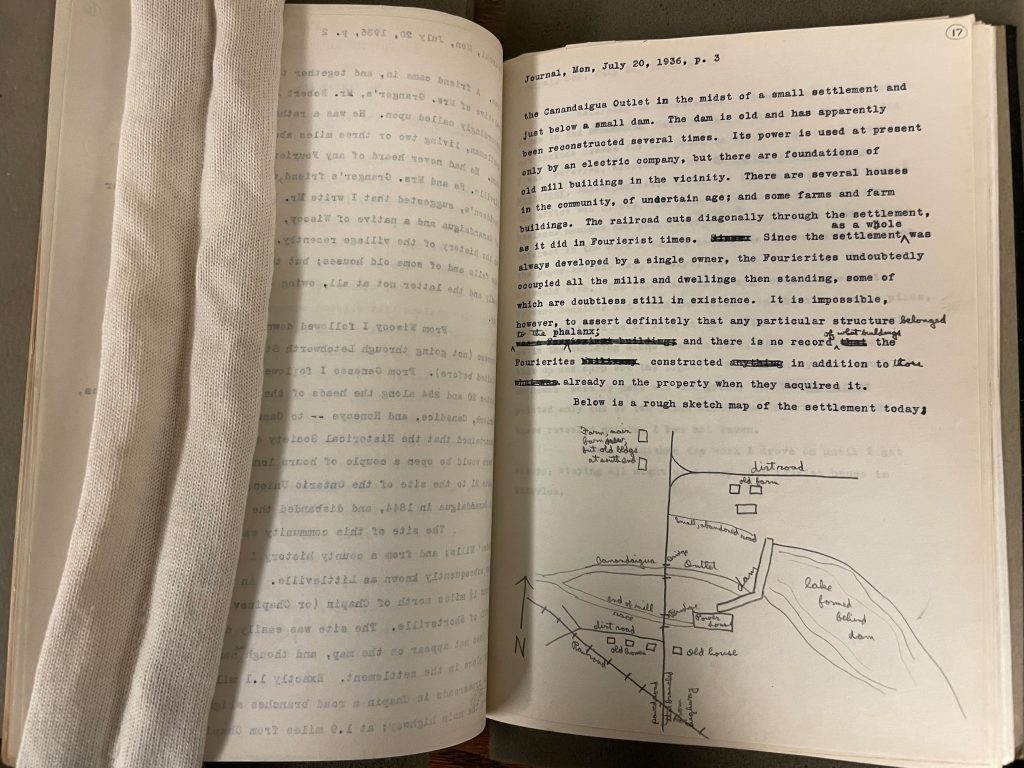
This travel journal, a mix of handwritten and typed notes, was created during several of Bestor’s research trips taken between September 1932 and March 1949. Bestor traveled to the sites of previous colonies along the East Coast, as well as their nearby local historical societies and libraries. Bestor would occasionally sketch a map of the sites in pencil, and would often annotate his own typed notes, giving insight into his thorough documentation process.
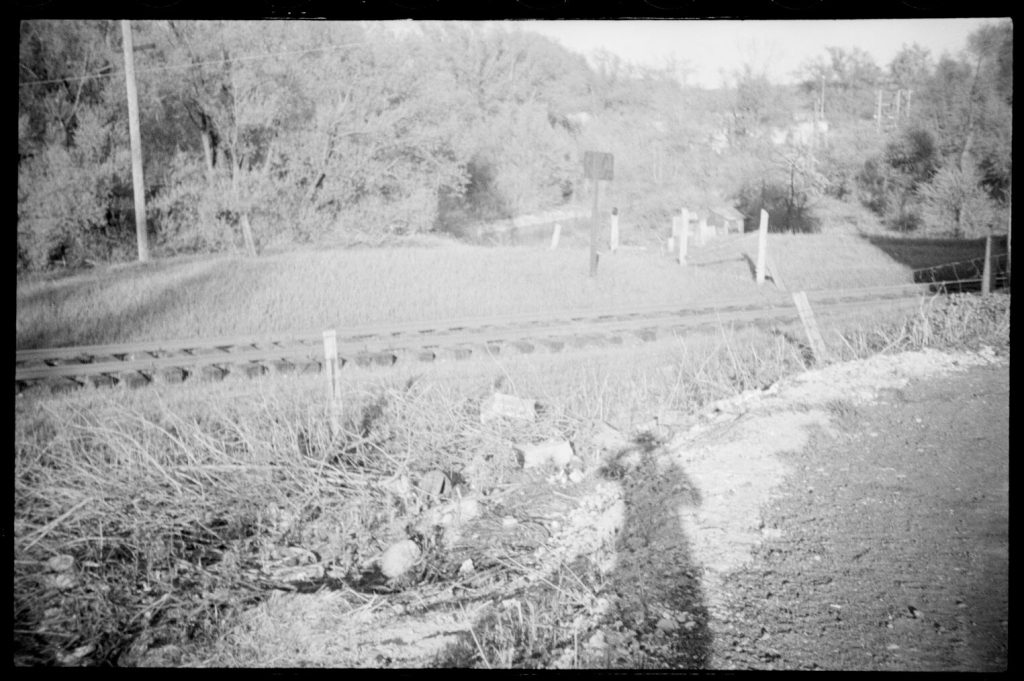
To accompany his travel journal, Bestor would also take photographs of each phalanx he visited. This photograph complements the displayed page in Bestor’s travel journal, as both document the same trip. Bestor’s original nitrate negatives were digitized in 2018 and are available in the University Library’s Digital Collections.
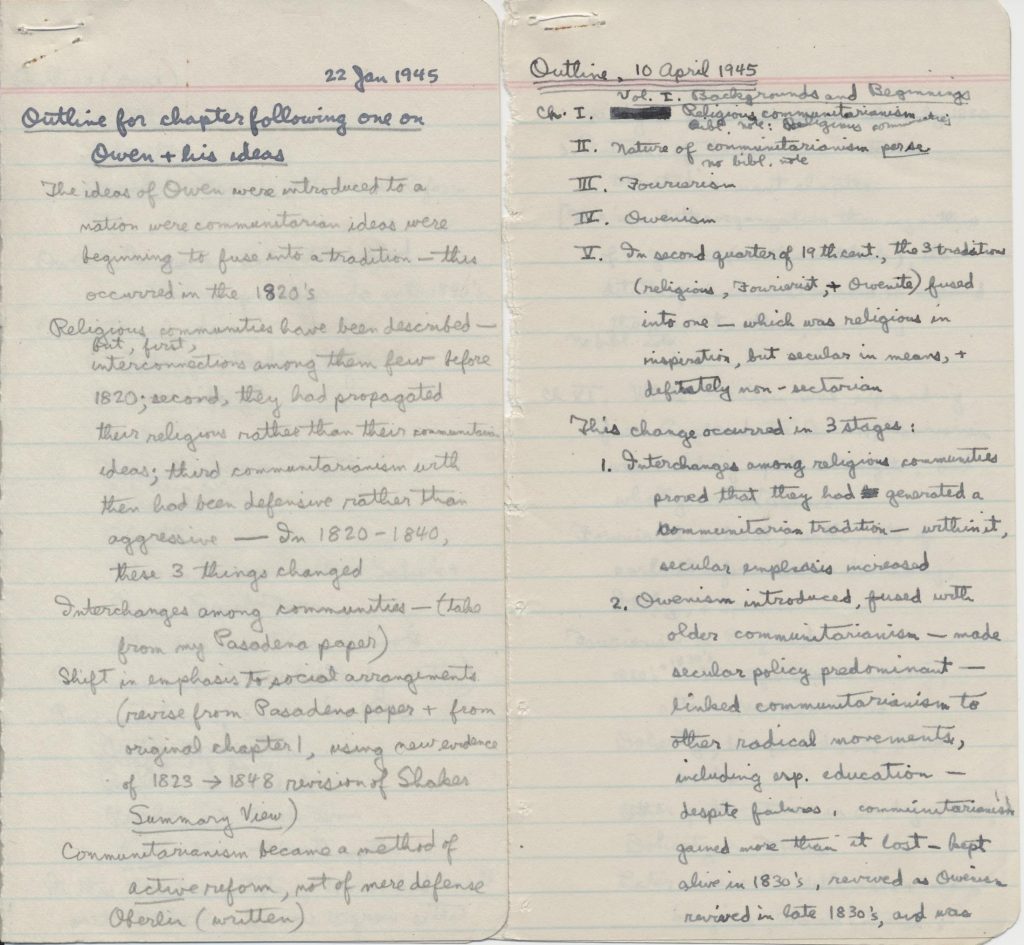
Although only the first volume was published, Bestor outlined Backwoods Utopias as a three-volume study on communitarianism. These outlines appear to be for his first volume; however, it seems as though they were not reflective of the final draft. Bestor ultimately decided to use his first volume, published in 1950, to briefly introduce communitarianism, and then focus on Owenism and New Harmony. His second volume on Fourier, which he considered titling Phalanxes of Social Reform: The Coming of Fourierist Socialism to America, 1838-1845, was never finished.
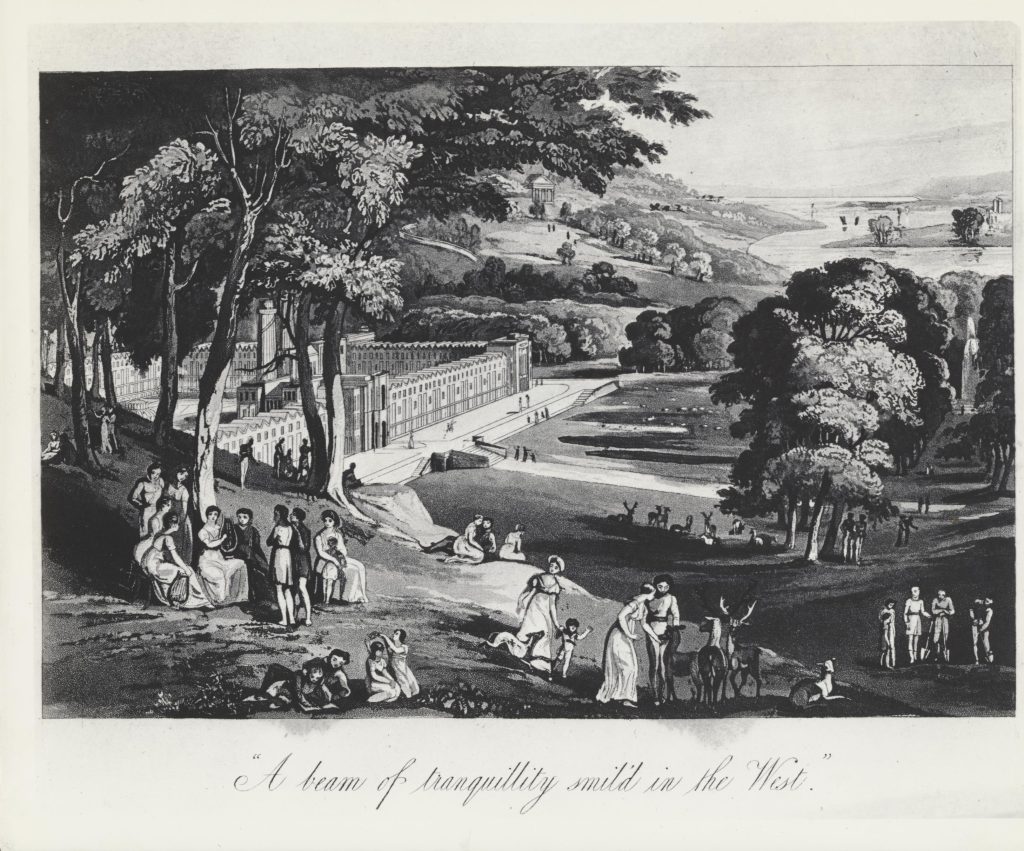
Bestor copied this illustration depicting an ideal Owenist community to accompany a review for his book, Backwoods Utopias, which was published by University of Pennsylvania Press on March 10, 1950. This illustration depicts people coexisting together on a hillside near the main edifice of a colony. In this painting, no one is working, and everyone is leisurely.
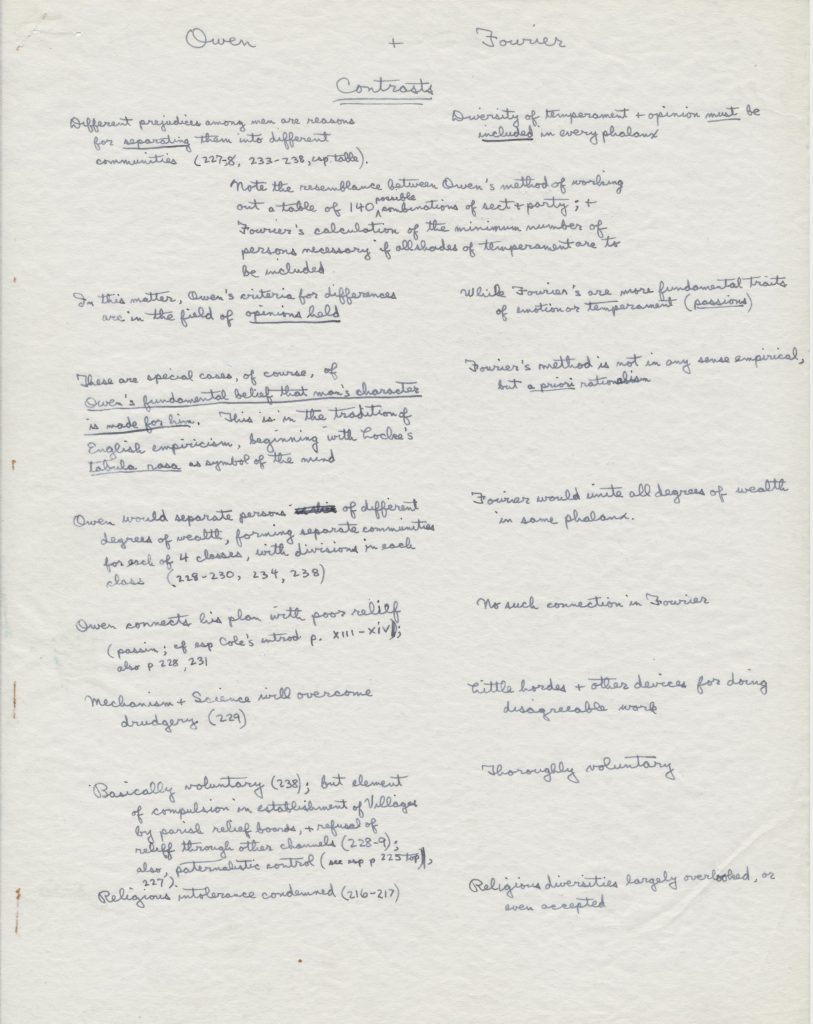
This note of Bestor’s compares Fourierism and Owenism. The main difference between the two theorists was Owen’s belief that dividing colonies based on wealth and ideologies, along with promoting mechanic and scientific advances, would overcome unhappiness. Fourier instead valued voluntary labor and roles, as well as a return to agriculture. Fourier considered diversity imperative for communal success and universal harmony. Another Bestor note, considering the similarities, illustrates that both theorists believed communitarianism would be the “end of poverty, crime, antagonism” and would create overall happiness and “attractive labor”—a society of workers who find pleasure in their work.
Items from MS 487: Albert Brisbane Papers, 1830-1832, 1840-1936
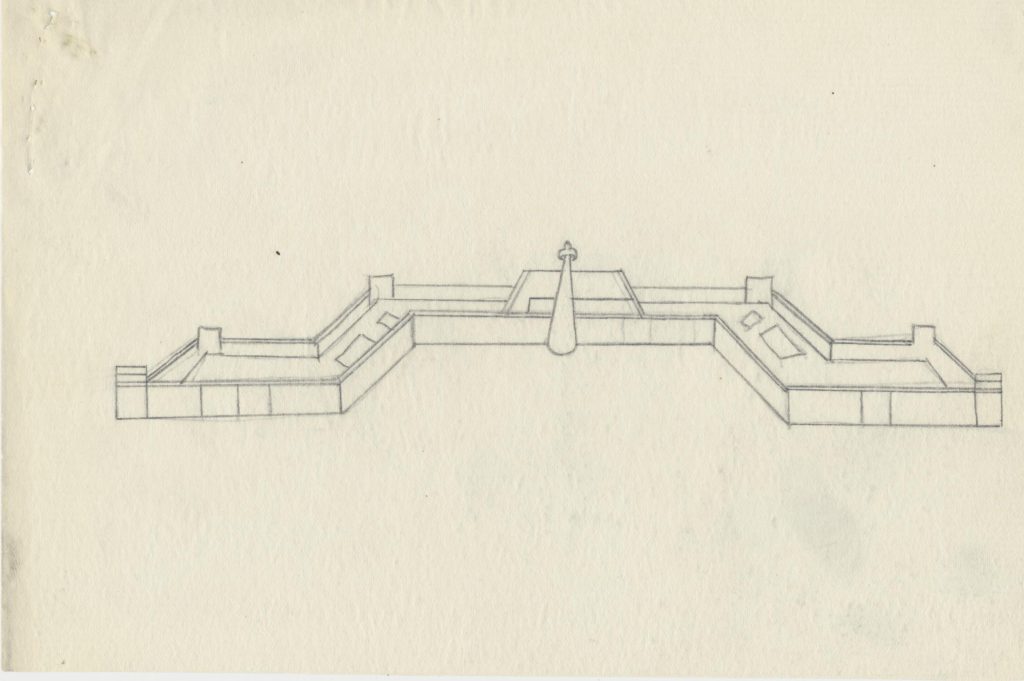
Brisbane sketched out (with drawings and in words) the ideal main building of a colony. He believed a colony was ideal at 2,000 people, and at 1,800, “all varieties of talents, capacities, tastes and characters can be united, which are necessary for a successful prosecution of all branches of industry, Art, and Science.” Brisbane also sketched out the grounds of an Association (colony), including a public square, a large hall for social events, granaries, storehouses, gardens, courtyards, and other outbuildings.
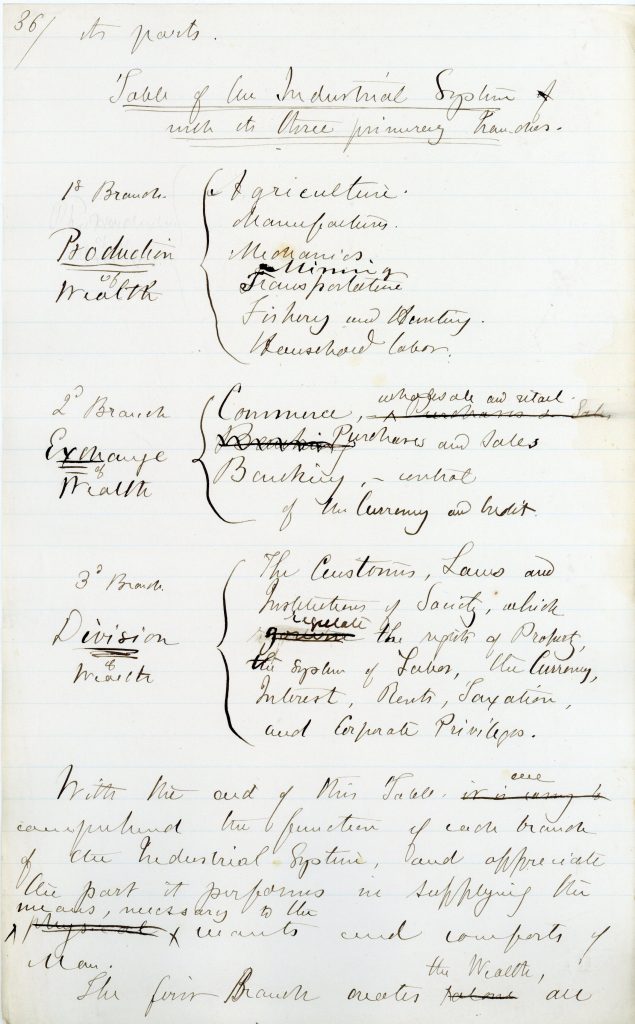
Brisbane’s papers were rooted in the ideas and language of Fourier, and many include illustrated tables that highlight Fourier’s Divisions of Industry, Laws of Order and Harmony, Social Reform and Organization, and the Series of the Passions, among others. Here, Brisbane illustrated the three branches of the Industrial System: production of wealth, exchange of wealth, and division of wealth. Such concepts were central in understanding the importance of industrial reform and self-sufficiency to American Fourierists. Brisbane’s tables emphasized that Fourierist communitarianism was not only secular, but economic.
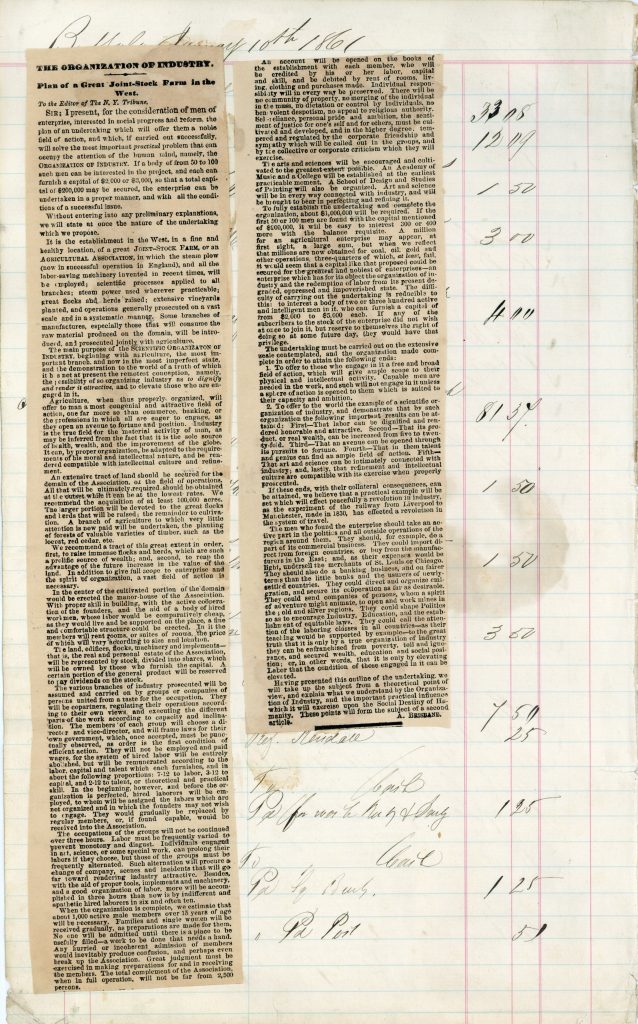
Editor Horace Greeley gave Albert Brisbane, the American promoter of Fourierism, a recurring column in the New York Tribune. Brisbane used the column to promote the social value of Fourierism and the implementation of its theories, which he called “Association.” Brisbane’s column established American interest in communal living, and several Fourierist sites were created in New England throughout the 1840s. IHLC has most of Brisbane’s Tribune articles, which have been clipped out and placed into a scrapbook (“The Labor Question”). The columns are glued on what appears to be old budget sheets written by Brisbane.
Case 2: Communitarianism in Practice
During the second half of the 19th century, communitarian colonies were built throughout the Northeast and Midwestern United States. Many followed Fourier’s theories, some followed Owen’s, and other colonies followed less prominent social reformers, such as Ètienne Cabet, a French philosopher (and friend of Owen’s) whose ideas influenced the Icarian colonies founded in Illinois, Missouri, Iowa, and Texas. The Icarian colony in Nauvoo, Illinois, ran from about 1849-1857. After the colony disbanded due to internal conflicts and declining interests, some members joined an Icarian colony in Iowa.
Colonies were often experimental fixes for economic hardships. Many grew out of the socialist labor movement, such as California’s Llano del Rio Co-operative Colony, established in 1913. Facing poor living and working conditions, members of Llano del Rio left and formed the Llano Co-operative Colony in Louisiana in 1917. In 1933, writer and publisher Bob Brown (1886-1959) was invited to stay at Llano to gain first-hand knowledge of communal life. His ten-month stay culminated in a book titled, Can We Co-Operate? (1940). Even the US government experimented with cooperative living, as the Resettlement Administration created New Deal Towns in the 1930s to combat Depression-era conditions. One thing all colonies had in common was their lack of success, ultimately succumbing to a shortage of resources, disagreements in operation, waning interest, or controversy. In one of Arthur Bestor’s many outlines for his second volume on communitarianism (left unfinished), he titled a chapter, “Nothing Fails Like Failure.”
Items from MS 468: Arthur E. Bestor Research Collection on Communitarianism, 1935-1962
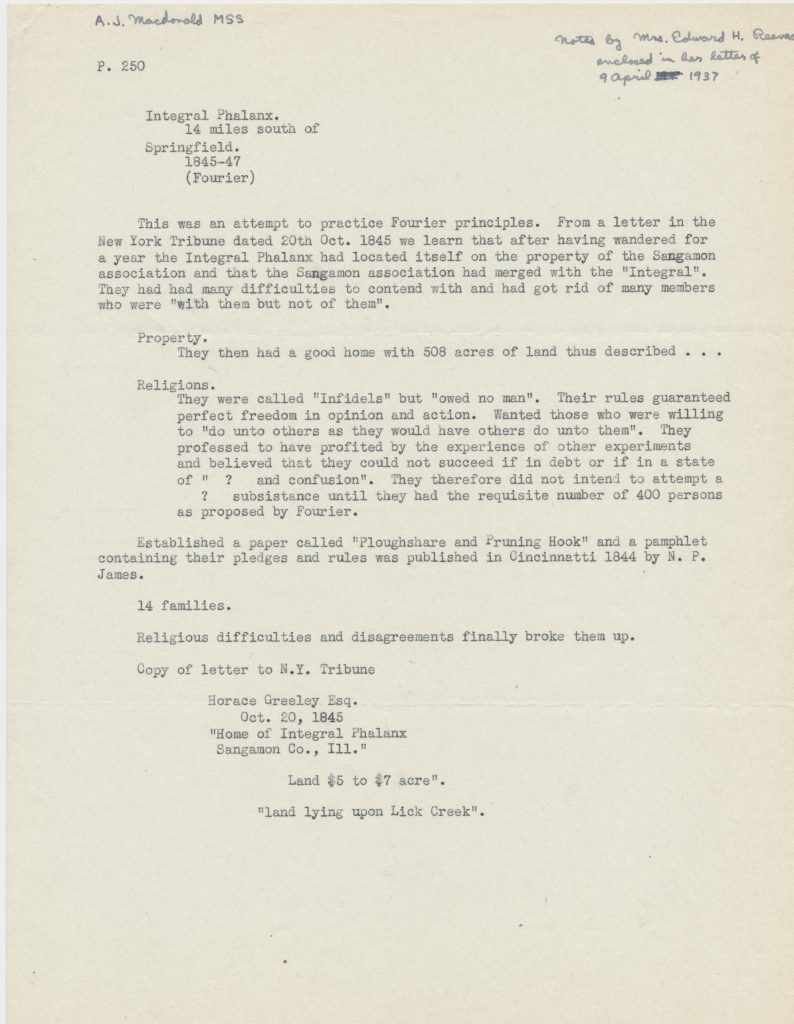
The origin of this note is partially unknown, however, “A.J. Macdonald MSS” is inscribed the top left corner in Bestor’s hand, suggesting that he found this within Macdonald’s papers. (IHLC has the A.J. Macdonald Papers, 1851-1854 on microfilm, likely because of Bestor’s research.) The top right corner of the note says, also in Bestor’s hand, “Notes by Mrs. Edward H. Reeves, enclosed in her letter of 9 April 1937,” suggesting that Reeves sent a letter to someone with this information contained in it.
The note is about a colony 14 miles south of Springfield, Illinois, which ran from 1845-1847. First named the Sangamon Phalanx and then the Integral Phalanx, the colony consisted of 14 families (about 120 people) on 508 acres of land. In a letter to the New York Tribune, the phalanx advertised: “Land $5 to $7 an acre. Land lying upon Lick Creek.” The colony dissolved not long after its founding due to organizational differences amongst the members.
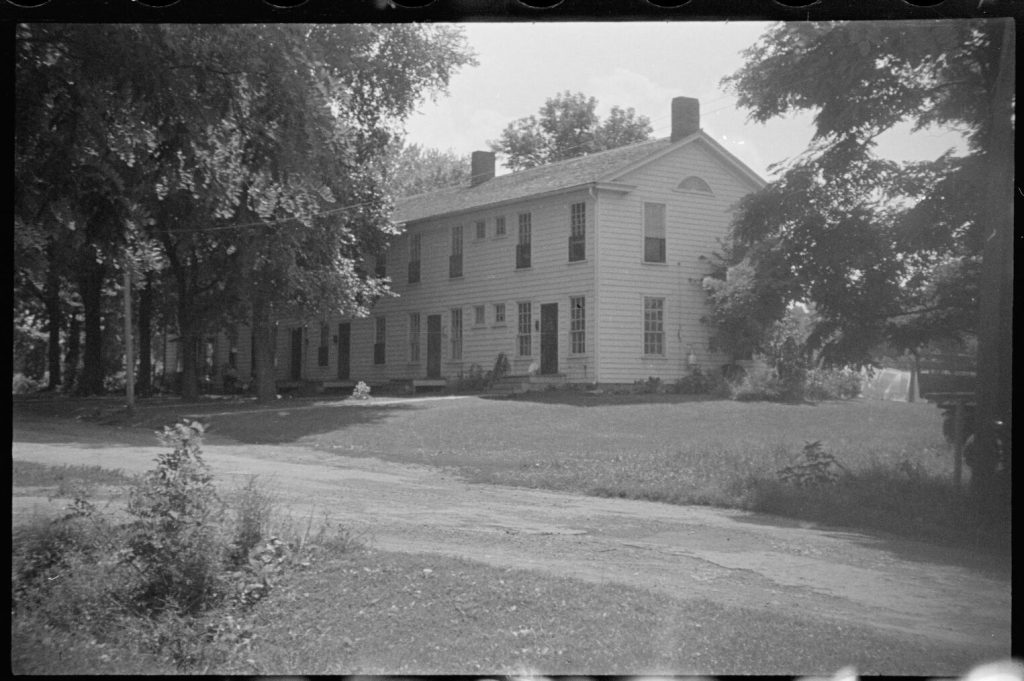
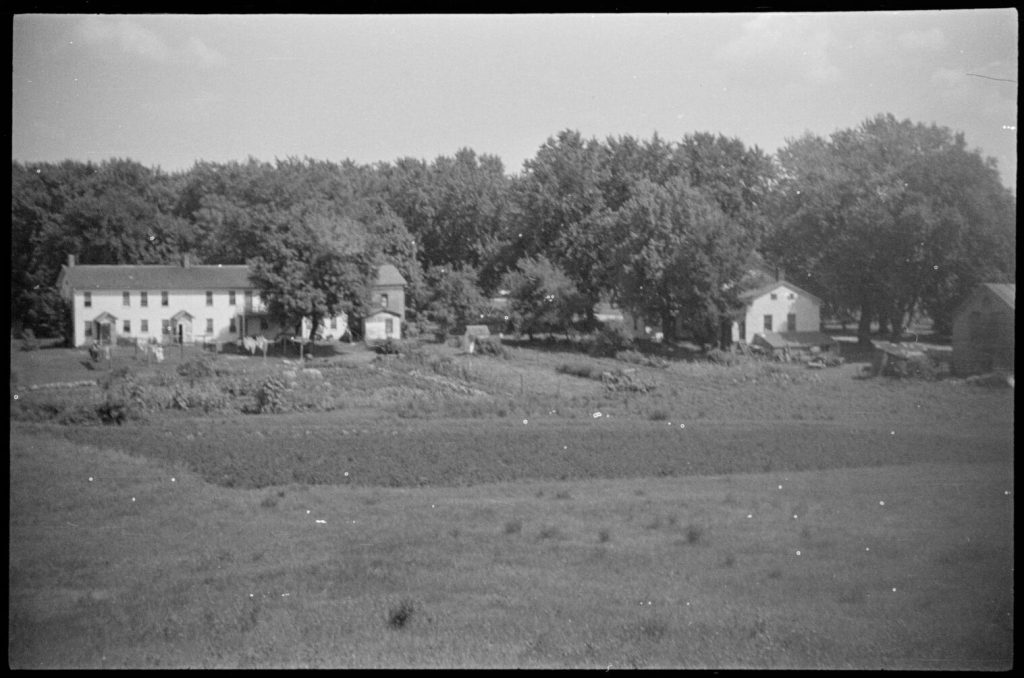
Item 2: Photographs of Wisconsin Phalanx site in Ceresco, Wisconsin. Taken by Arthur Bestor, 1946. MS 468: Part 2, Box 9, Folder IV. H.16
Arthur Bestor took these photographs in 1946 during a trip to the site of the Wisconsin Phalanx. This colony was founded in 1844 by Warren Chase and at its peak had nearly 200 residents. These photographs are of the Long House, the building that held the living quarters and shared kitchen spaces. Eventually, members of the phalanx grew restless with the communal living aspect, and jobs were becoming less guaranteed. Numbers fell and the colony dispersed in 1850.
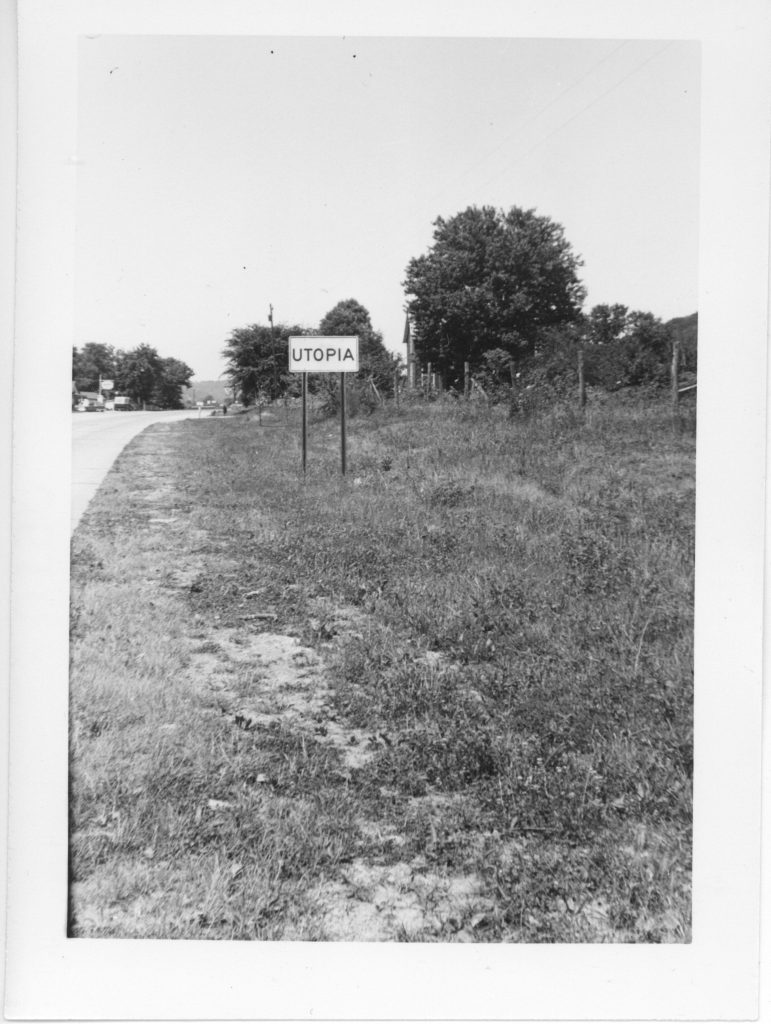
Bestor took this photograph during one of his many trips to the sites of past communitarian phalanxes. Utopia, Ohio, was founded first in 1844 by Fourierists from Ohio’s Clermont Phalanx. The phalanx lasted about three years. The land was then settled upon by Josiah Warren, who had lived in Robert Owen’s New Harmony colony from 1825-1827. Back in Ohio, Warren created his own version of Utopia, which existed in some capacity for nearly twenty years. Warren went on to found other colonies, such as the Modern Times colony in New York—all of which focused less on communal wealth, and more on economic individualism.
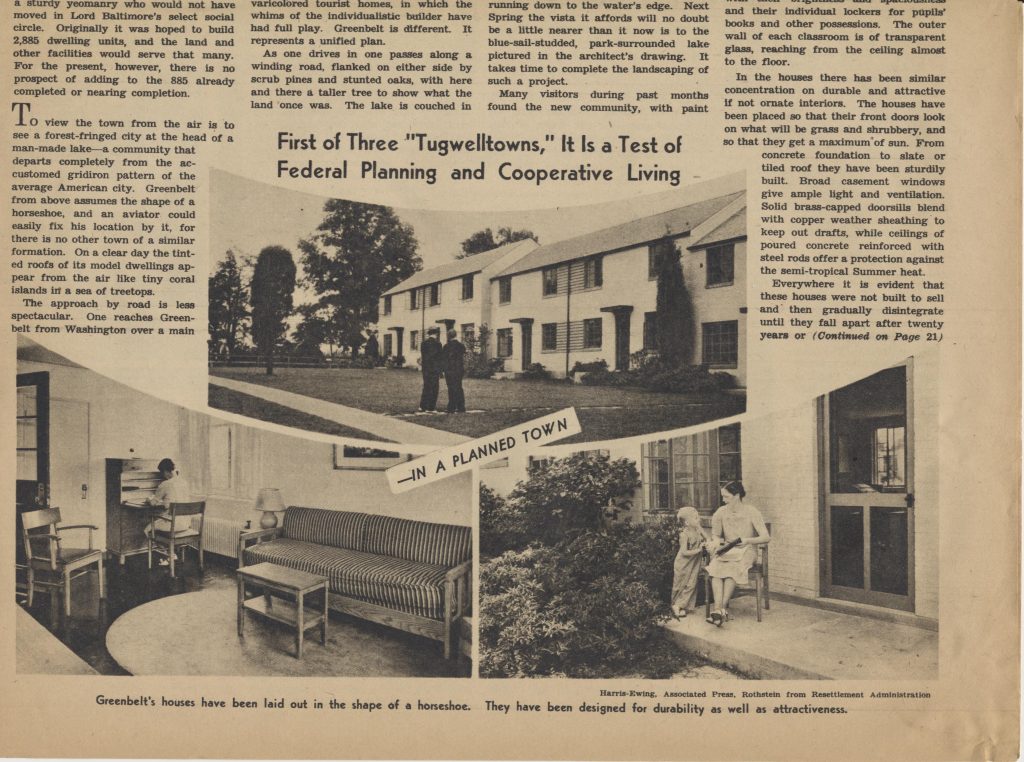
Bestor’s research alluded to the idea that communitarianism was often related to economic hardship. Many 20th-century colonies were experimental fixes during the depression era. This article highlights the opening of a model town in Greenbelt, Maryland. During the 1930s, co-operative living was a mix of idealism and practicality. The federal government’s Resettlement Administration created New Deal (“model” or “greenbelt”) towns to combat housing and labor shortages. These were “low-rent suburban communities for low-income families” modeled on the European garden city movement. Greenbelt had 885 dwelling units laid out in a horseshoe shape, perhaps influenced by the Fourierist model.
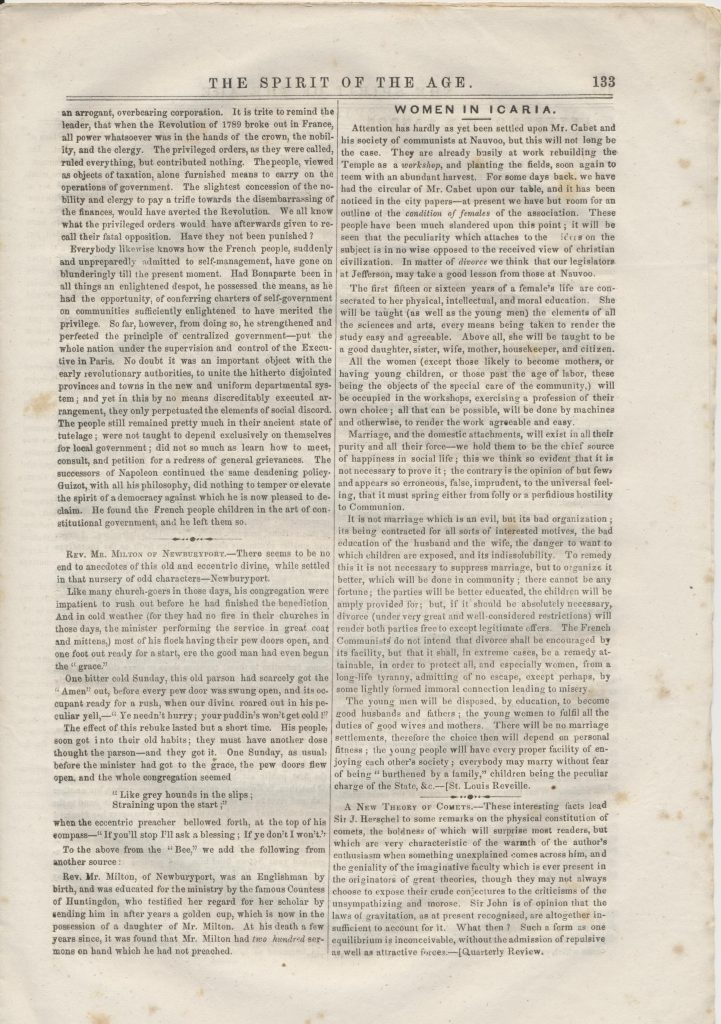
This philosophical journal compiled several articles about communitarian societies and their ideologies. Issue 9 includes an article on Fourier and an article titled “Women in Icaria,” which described the role of women who lived in Icaria, a colony established by followers of French utopian socialist Étienne Cabet. The Icarians settled in Nauvoo, Illinois, from about 1849-1857. They viewed marriage as a personal duty and allowed divorce as a means of freeing women from tyranny. Editor W.H. Channing was a Transcendentalist and Christian socialist who edited this journal along with several other Fourierist journals.
Items from MS 492: Bob Brown Research Collection on Communitarian Colonies, 1919-1942
Another wave of practiced communitarianism took place in the early 20th-century co-operative living movement. Like Arthur E. Bestor, Bob Brown (1886-1959) studied communal colonies throughout the United States. Brown experienced colony life first-hand by staying briefly with the Llano Co-operative Colony (or “New Llano”), founded in Newllano (now New Llano), Louisiana, in 1917. Llano was preceded by the Llano del Rio Colony, founded by socialist Job Harriman in California in 1913.
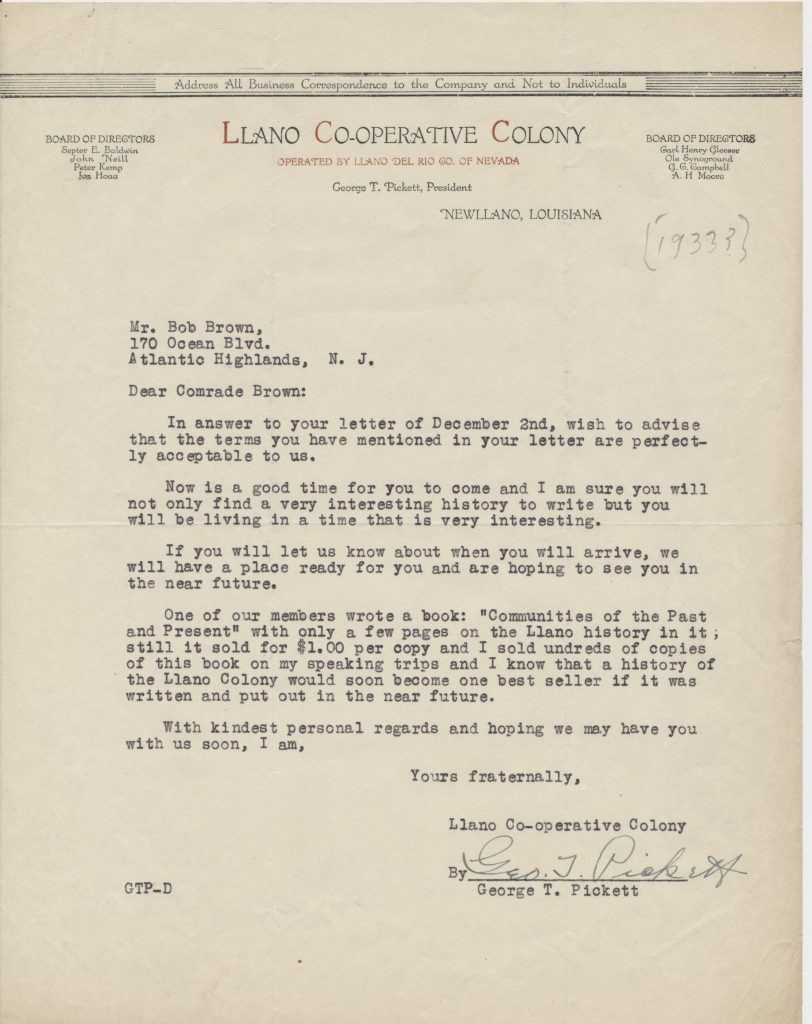
George T. Pickett, general manager of the Llano Co-operative Colony, invited Bob Brown to stay at Llano while researching and drafting his book, Can We Cooperate? (1940). During his stay, Brown observed how the colony functioned. For his research, he sent out questionnaires to other colonies in the United States and abroad requesting members to comment on the food, work, cost, housing, and the general environment of the colony. George T. Pickett and the Llano Co-operative Colony declared bankruptcy three years later, in 1936, and dispersed in 1939.
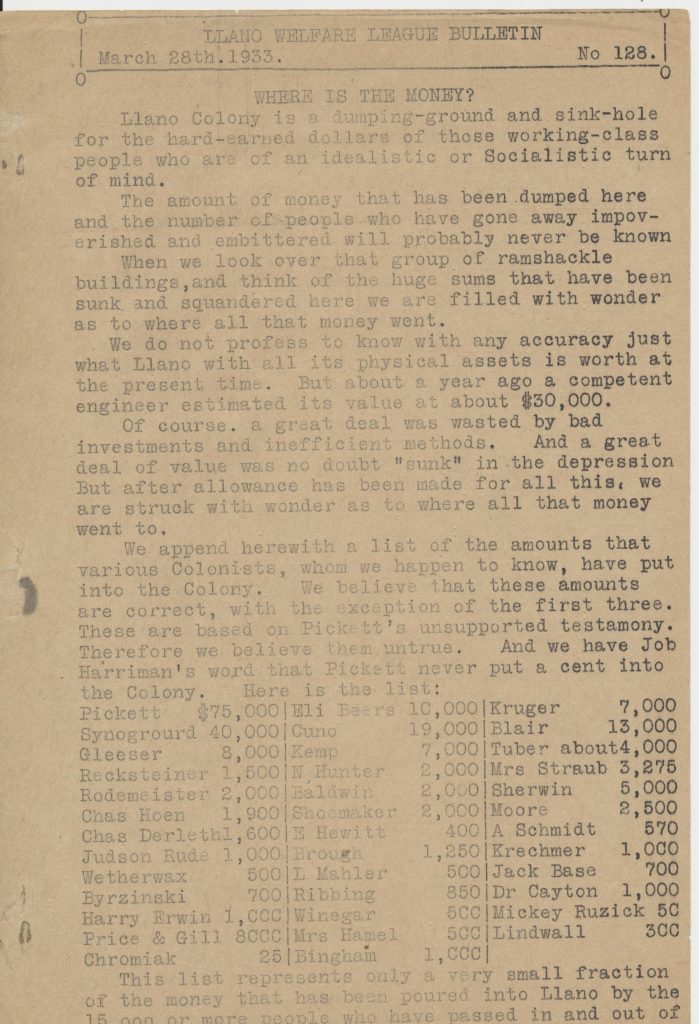
This bulletin, written by members of the Llano Colony in 1933, questions the trustworthiness of general manager George T. Pickett. During this time, some members of the colony wanted to oust Pickett and start a new board. The bulletin gives us insight into one of the various ways in which colonies tended to fail: power struggles and internal conflict.
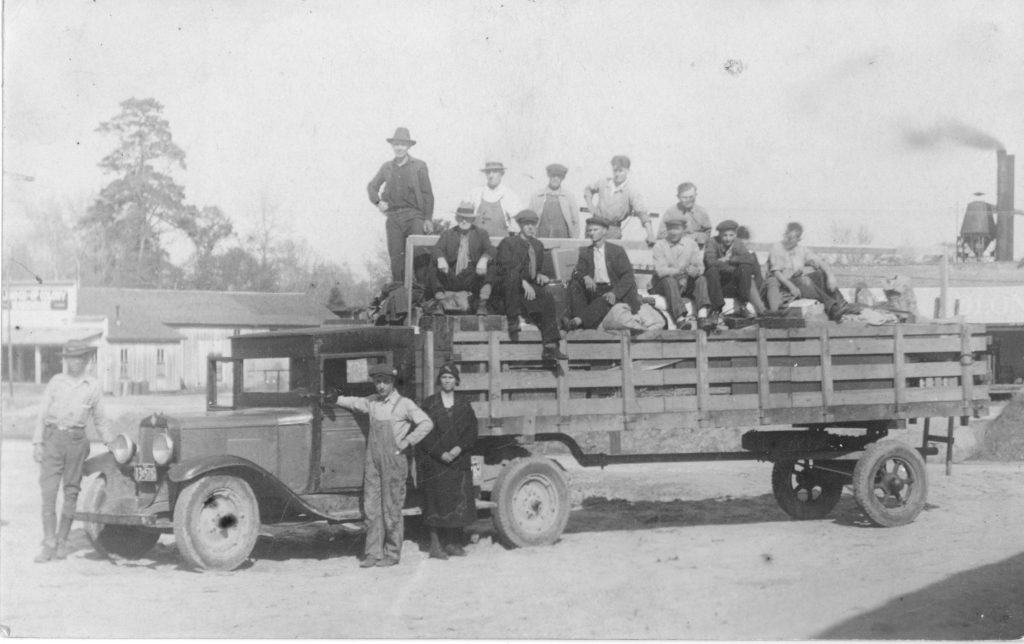
This postcard is from the Llano Co-operative Colony and pictures workers posing on a truck during a work break. In an interview with Bob Brown, a member (possibly Pickett) says, “Llano differs from most colonies in that it is not attempting to compete with capitalism; its aim is to do away with competition entirely and produce for use instead of profit.”
SELECT IHLC RESOURCES FOR FURTHER STUDY:
MS 468: Arthur E. Bestor Research Collection on Communitarianism, 1935-1962
MS 492: Bob Brown Research Collection on Communitarian Colonies, 1919-1942
